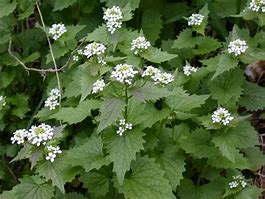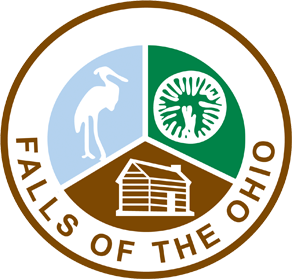
It might be said that a weed is just a plant growing where it doesn’t belongs. To gardeners, weeds are an inconvenience. To wildlife, they can be a disaster! One plant that has become a real nuisance now widespread in the Ohio Valley is garlic mustard (Alliaria officinalis). This European import spread from Long Island, New York in 1868.
Garlic mustard is a biennial, producing an inconspicuous rosette of leaves in its first year, before reaching to 2 to 3 ½ feet tall in the second. It produces small white flowers with four petals which provide no nutrition to pollinating insects. The plant absorbs nutrients out of the soil making it difficult for other plants to survive. When garlic mustard is pulled, it is difficult to establish other plants in their place. The plant is partial to soils associated with limestone bedrock – that includes much of Kentuckiana. It thrives in areas that have been disturbed, but will not handle highly acidic soil.
Garlic mustard frequently gets established along stream banks. When the plant matures in its second year, the seed pods explode, shooting them as far as six feet away. Its seeds may be carried by water into new areas. Animals that brush against them will get showered, spreading seeds further as they trek into the habitat. This plant can out-compete almost any other low-growing native annual or perennial in a shady habitat, until it becomes a waist-high “lawn.”
Seeds remain viable as long as seven years, and hundreds may be produced by one plant. That means it takes a long time to exterminate them from a natural habitat or garden once they become well-established. The easiest way to remove this noxious weed is to wait until the soil is moist and grab the plant as close to the base as possible to pull them up. If you leave a piece of a root, it will re-grow. Try to get them up when you see the first tiny cluster of white flowers (if not earlier). Plants should be removed from the area completely – don’t just pull and drop. They can re-root or, if in bloom, may still go to seed. Don’t compost them after they have gone to seed.
Although a large patch of garlic mustard can be overwhelming, it can be controlled. Get together with friends and have a garlic mustard pull party. If established, make it an annual spring-time event. Work with neighbors to eliminate the plant in your area. At the Falls of the Ohio State Park, we have been removing garlic mustard along our Woodland Loop Trail for years. We have cleared areas completely, only to have scattered plants reappear (perhaps from dogs being walked on the trail where seeds drop off their fur), so constant vigilance is necessary.
If you have a natural space, consider planting nursery-grown native plants and ferns. With dense vegetation, or a good mulch barrier, it may be more difficult for garlic mustard to re-establish itself. In a garden, where ground covers are preferred over masses of perennials or annuals, consider using non-invasive varieties like creeping phlox (Phlox subulata), Green and Gold (Chrysoganum virginianum), some ferns, creeping juniper, etc. The plant selection depends on the amount of sun. Don’t replace it with other invasives like English Ivy, Periwinkle, or Common Honeysuckle.
There are numerous websites with information about garlic mustard and its removal. This document is a reliable source for information: https://www.invasive.org/weedcd/pdfs/wgw/garlicmustard.pdf.
By removing garlic mustard from your land or neighborhood, you will help our local food web recover from a debilitating species. Keep Kentuckiana beautiful!
